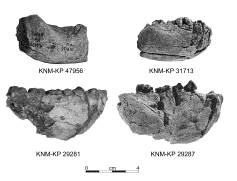New fossils of Australopithecus anamensis from Kanapoi, West Turkana, Kenya (2003–2008)
C.V. Ward, F.K. Manthi, J.M. Plavcan
Source - http://www.sciencedirect.com/science/article/pii/S0047248413001437
Journal of Human Evolution
Abstract
Renewed fieldwork from 2003 through 2008 at the Australopithecus anamensis type-site of Kanapoi, Kenya, yielded nine new fossils attributable to this species. These fossils all date to between 4.195 and 4.108 million years ago. Most were recovered from the lower fluvial sequence at the site, with one from the lacustrine sequence deltaic sands that overlie the lower fluvial deposits but are still below the Kanapoi Tuff. The new specimens include a partial edentulous mandible, partial maxillary dentition, two partial mandibular dentitions, and five isolated teeth. The new Kanapoi hominin fossils increase the sample known from the earliest Australopithecus, and provide new insights into morphology within this taxon. They support the distinctiveness of the early A. anamensis fossils relative to earlier hominins and to the later Australopithecus afarensis. The new fossils do not appreciably extend the range of observed variation in A. anamensis from Kanapoi, with the exception of some slightly larger molars, and a canine tooth root that is the largest in the hominin fossil record. All of the Kanapoi hominins share a distinctive morphology of the canine–premolar complex, typical early hominin low canine crowns but with mesiodistally longer honing teeth than seen inA. afarensis, and large, probably dimorphic, canine tooth roots. The new Kanapoi specimens support the observation that canine crown height, morphology, root size and dimorphism were not altered from a primitive ape-like condition as part of a single event in human evolution, and that there may have been an adaptive difference in canine function between A. anamensis and A. afarensis.

Figure 3. KNM-KP 47953, associated mandibular teeth. Teeth figured in occlusal (above), lingual (middle) and mesial (below) views. From right to left, right canine P3, P4, M1, M3, left M3, left canine.

Figure 6. Lateral view of KNM-KP 47956 (reversed for comparison) compared with the previously published mandibles from Kanapoi and attributed to Australopithecus anamensis, KNM-KP 31713, KNM-KP 29281 (A. anamensis holotype), and KNM-KP 29287. All shown in lateral view.